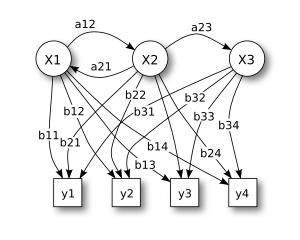How to Create a Mind
It would employ techniques such as hidden Markov models and genetic algorithms, strategies Kurzweil used successfully in his years as a commercial developer of speech recognition software.
Artificial brains will require massive computational power, so Kurzweil reviews his law of accelerating returns, which explains how the compounding effects of exponential growth will deliver the necessary hardware in only a few decades.
Yet critics admire Kurzweil's "impressive track record"[4] and say that his writing is "refreshingly clear",[5] containing "lucid discussions"[6] of computing history.
[7] One month after How to Create a Mind was published, Google announced that it had hired Kurzweil to work as Director of Engineering "on new projects involving machine learning and language processing".
[14] Kurzweil opens the book by reminding us of the importance of thought experiments in the development of major theories, including evolution and relativity.
[17] Later he asks the reader to visualize someone he has met only once or twice, the difficulty here suggests "there are no images, videos, or sound recordings stored in the brain" only sequences of patterns.
[23] He cites recent evidence that interconnections in the neocortex form a grid structure, which suggests to him a common algorithm across "all neocortical functions".
[26] Kurzweil believes these large scale simulations are valuable, but says a more explicit "functional algorithmic model" will be required to achieve human levels of intelligence.
[26] Kurzweil is unimpressed with neural networks and their potential while he's very bullish on vector quantization, hidden Markov models and genetic algorithms since he used all three successfully in his speech recognition work.
He contrasts the hand-coded knowledge of the Douglas Lenat's Cyc project with the automated learning of systems like Google Translate and suggests the best approach is to use a combination of both, which is how IBM's Watson was so effective.
He would add in a "critical thinking module" to scan existing patterns in the background for incompatibilities, to avoid holding inconsistent ideas.
Kurzweil says the brain should have access to "open questions in every discipline" and have the ability to "master vast databases", something traditional computers are good at.
This is in contrast to people like John Searle, Stuart Hameroff and Roger Penrose who believe there is something special about the physical brain that a computer version could not duplicate.
He also suggests that quantum mechanics may provide "a continual source of uncertainty at the most basic level of reality" such that determinism does not exist.
Kurzweil believes identity "is preserved through continuity of the pattern of information that makes us" and that humans are not bound to a specific "substrate" like biology.
It explains why computational capacity will continue to increase unabated even after Moore's Law expires, which Kurzweil predicts will happen around 2020.
Integrated circuits, the current method of creating computer chips, will fade from the limelight, while some new more advanced technology will pick up the slack.
[6] Colin McGinn, a philosophy professor at the University of Miami, asserted in The New York Review of Books that "pattern recognition pertains to perception specifically, not to all mental activity".
[6] Matthew Feeney, assistant editor for Reason, was disappointed in how briefly Kurzweil dealt with the philosophical aspects of the mind-body problem, and the ethical implications of machines which appear to be conscious.
"[42] While Drew DeSilver, business reporter at the Seattle Times, says the first half of the book "has all the pizazz and drive of an engineering manual" but says Kurzweil's description of how the Jeopardy!
[40] Matt Ridley, journalist and author, wrote in The Wall Street Journal that Kurzweil "has a more impressive track record of predicting technological progress than most" and therefore he feels "it would be foolish, not wise, to bet against the emulation of the human brain in silicon within a couple of decades".



